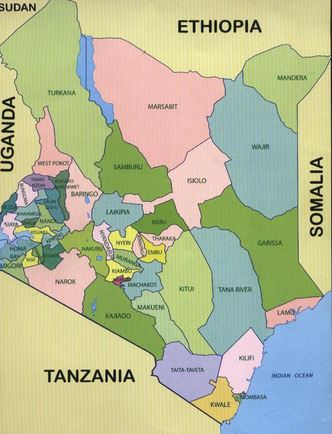| County Governments |
|---|
| Assessment Questions |
- Counties are geographical units within the country.
- Kindly, note the difference between COUNTY | COUNTIES and COUNTRY | COUNTRIES.
- The counties came to be as a result of the new constitution (2010 CONSTITUTION OF KENYA).
- This contributes to the formation of a county government for each county.
- There are 47 county governments in Kenya.
- The county governments were established based on the 1992 Districts of Kenya, after the scheduled general election of March 2013.
| 1. Mombasa | 2. Kwale | 3. Kili | 4. Tana River | 5. Lamu | 6. Taita/Taveta | 7. Garissa |
| 8. Wajir | 9. Mandera | 10. Marsabit | 11. Isioli | 12. Meru | 13. Tharaka-Nithi | 14. Embu |
| 15. Kitui | 16. Machakos | 17. Makueni | 18. Nyandarua | 19. Nyeri | 20. Kiriyaga | 21 Murang'a |
| 22. Kiambu | 23. Turkana | 24. West Pokot | 25. Samburu | 26. Trans Nzoia | 27. Uasin Gishu | 28. Elgeyo Marakwet |
| 29. Nandi | 30. Baringo | 31. Laikipia | 32. Nakuru | 33. Narok | 34. Kajiado | 35. Kericho |
| 36. Bomet | 37. Kakamega | 38. Vihiga | 39. Bungoma | 40. Busia | 41. Siaya | 42. Kisumu |
| 43. Homa Bay | 44. Migori | 45. Kisii | 46. Nyamira | 47. Nairobi City |
- Here are the counties on a map of Kenya.

- Each county government has a County Assembly and a County Executive Committee.
The County Assembly consists of:
- The County Executive Committee exercises the democratic authority of the citizens at the county level. This committee comprises:
The county executive committee performs the following duties:
- The governor is the chief executive of the county. All members of the County Executive committee are answerable to the Governor.
- The Governor is directly elected by voters in the county during the general elections.
- The duties of a county governor include:
1. To preside over the official opening of county government.
2. To oversee the implementation of county legislation.
3. To supervise the management of county departments.
4. To appoint members of the County Executive Committees with approval from the County Assembly.
5. To chair country executive committee meetings.
- County governments have the responsibility to provide services to the people who live within their jurisdiction.
- This is because the central government cannot reach each and every small corner or individual in the country.
- It is the county governments that supplement government effort in providing services to the people.
- Since they operate at the community level, county governments are able to attend to problems affecting a community or an individual.
- Responsibilities depend on the status of the county government.
1. Collecting revenue:
To be able to provide services, county governments must collect levies from those living in their areas of jurisdiction.
Levies charged include the following:
2. Providing health services:
County governments set up dispensaries and clinics for use by the residents of the area. The authorities also employ health workers to operate in those centres.
3. Building and maintaining road:
County governments have the duty to ensure that they build and maintain roads in the areas under their jurisdiction.
4. Providing nursery and primary schools:
County governments also operate nursery and primary schools within the areas of their jurisdiction. They also ensure that the schools have qualified teachers.
5. Collecting garbage:
It is the duty of the county government in charge of a town to ensure that the town is clean by employing cleaners and collecting waste and ensuring it is appropriately disposed of.
6. Providing sewerage and drainage services:
County governments in charge of urban areas also ensure that a town has proper drainage and sewerage systems.
7. Providing water:
County governments are expected to ensure that residents are supplied with clean water for domestic and other uses.
8. Allocating land for special uses:
County governments that are in charge of urban areas provide cemeteries.
They also provide sites for traders to set up markets.
9. Protecting public land:
County governments have the responsibility to ensure that land set aside for public use like recreational areas, schools, health centres, and forest land is not grabbed by individuals for personal use.
10. Passing by-laws:
County governments are empowered by the central government to pass by-laws and to regulate the operations in the areas under their jurisdiction.